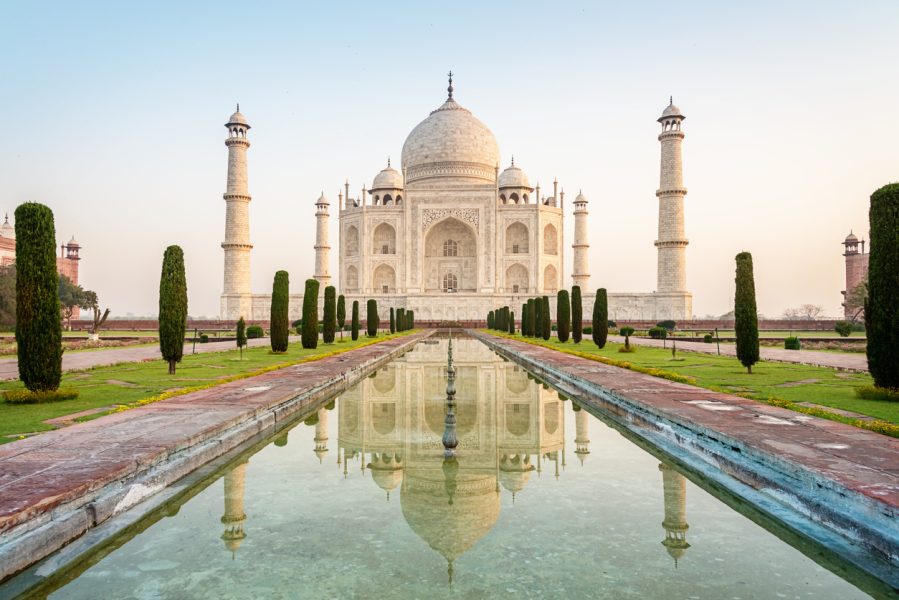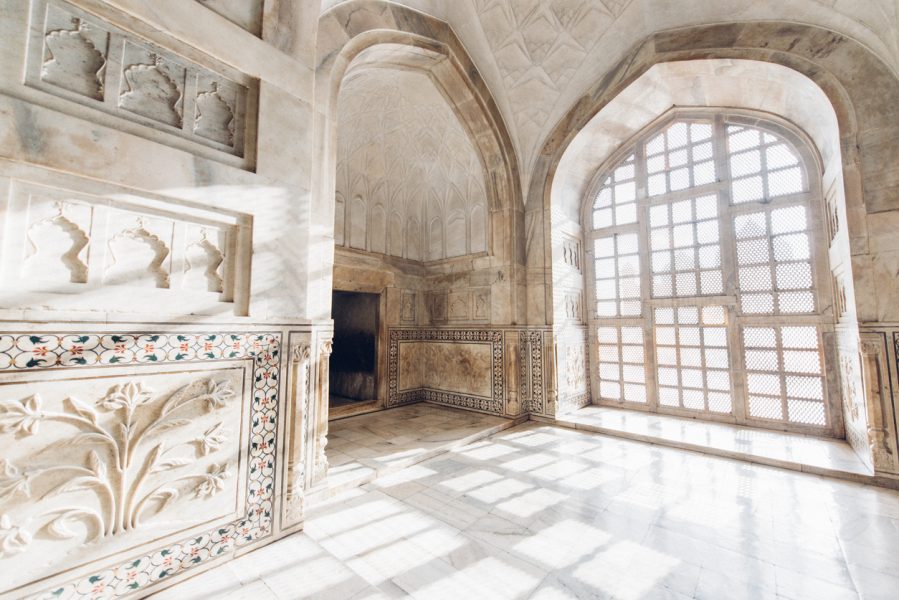
Tejo Mahalaya vs Taj Mahal: What's feeding a conspiracy theory
A recent petition seeking a directive to the ASI to open 22 rooms inside the Taj to see if it has Hindu idols stems from a conspiracy theory; experts pooh-pooh the claims

“An immense mausoleum of white marble, built in Agra between 1631 and 1648 by order of the Mughal emperor Shah Jahan in memory of his favourite wife, the Taj Mahal is the jewel of Muslim art in India and one of the universally admired masterpieces of the world’s heritage,” says Unesco, which lists the Taj as a world heritage site.
However, the mausoleum has been in the news yet again over a conspiracy theory that won’t go. The BJP media in-charge of Ayodhya district recently filed a petition in the Lucknow bench of the Allahabad High Court, requesting a directive to the Archaeological Survey of India (ASI) to open 22 rooms inside the Taj Mahal to ascertain if the claims that the mausoleum houses Hindu idols were true.
In his petition, Rajneesh Singh, the BJP functionary, also sought a direction to form a fact-finding panel that would look for any “historical evidence” including Hindu idols or inscriptions that are believed to have been hidden inside the Taj Mahal on the orders of Mughal emperor Shah Jahan.
Right-wing support
Interestingly, Singh’s petition is based on a conspiracy theory supported by right-wing thinkers and historians, that the 17th century Mughal marvel was an old Shiva temple called ‘Tejo Mahal’.
The conspiracy theorists quote historical revisionist PN Oak, who in his book The Taj Mahal is Tejo Mahalaya: A Shiva Temple, claims that the world-reputed monument, commissioned by Shah Jahan in the memory of his favourite wife Mumtaz Mahal, was built on the foundations of a Shiva temple after being commandeered from the then ruler of Jaipur.
From raising questions on the nomenclature of the monument, to its architecture – which he claims bears imprints of a Hindu temple structure – to the famed love story of Shah Jahan and Mumtaz Mahal, Oak gives an extensive list of purported ‘anomalies’ which attempts to negate legends associated with the world heritage site.
He claims the term Taj Mahal does not occur in any Mughal court paper or chronicle, even in Shah Jahan’s son and successor Aurangzeb’s time, and is a corrupted form of the Sanskrit term ‘Tejo Mahalaya,’ an abode of Agreshwar Mahadev, the ‘Lord of Agra’. He further claims that the Hindu treatise on architecture, Viswa-karma Vastushastra, mentions the ‘Tej Linga’ among the many Shiva Lingas in the country. He alleges it is the same idol that was consecrated in the Taj Mahal and hence would have lent it the name Tejo Mahalaya.
Also read: Open locked rooms in Taj Mahal to unearth Hindu idols: Plea filed in HC
“The spot occupied by Mumtaz’s cenotaph was formerly occupied by the Hindu Teja Linga…that emblem may still lie buried in the cenotaph for all we know,” he claims.
According to historical records, Taj Mahal is named after Emperor Shahjahan’s wife Mumtaz Mahal. But, Oak claims the real name of Mumtaz was Mumtaz-ul-Zamani.
“‘Mahal’ is never Muslim because in none of the Muslim countries around the world, from Afghanistan to Algeria, is there a building known as ‘Mahal’,” he claims.
Tomb architechture
Pointing to the architecture of the tomb, Oak claims even noted architects including EB Havell, Mrs Kenoyer and Sir WW Hunter have said on record that the Taj Mahal borrows its style from the Hindu temple architecture. Oak says, while the central dome with cupolas at its four corners is a feature of Hindu temples, the octagonal shape of the mausoleum itself is characteristically Hindu in style as it stands for the eight directions assigned to as many celestial guards in Hinduism.
He says the structure has a reverberating dome, essentially a feature in temples to help amplify the sound of bells. While pointing fingers at the lotus cap on the dome of the tomb, a purported deviation from the bald top seen in Islamic domes across the world, Oak avers the ‘mahal’ faces south, even though Islamic buildings face west.

Oak claims that dissimilar stone structures on walls leading to Mumtaz’s tomb show that these were actually sealed doorways to passages to other rooms in the basement. He claims that Shah Jahan sealed off these chambers, walling them with whatever stones that came in handy, and that these were the rooms where statues of Hindu gods – including a “beheaded image of Lord Shiva” – have been allegedly kept hidden.
Oak dismisses all romantic stories related to Shah Jahan and Mumtaz. He claims that the fact that various dates have been given for Mumtaz’s death – 1629, 1630, 1631 or 1632 – shows how insignificant she was in a harem of 5,000 women and thus, according to him, didn’t deserve a Taj Mahal.
“Stories of Shah Jahan’s exclusive infatuation for Mumtaz are concoctions. They have no basis in history nor has any book ever been written on their fancied love affair. Those stories have been invented as an after-thought to make Shah Jahan’s authorship of the Taj look plausible,” he claims.
‘Typical Islamic architecture’
Non-partisan archaeological experts are clear that the Tejo Mahalay claim is just a right wing conspiracy. “The existence of several historical and Quaranic inscriptions in Arabic script has facilitated setting the chronology of Taj Mahal,” says Unesco.
One of the most outstanding features of the Taj is its Mughal architecture, although its style combines elements from Persian, Ottoman Turkish and Indian architecture, say experts. The style is said to have been inspired by certain Timurid and Mughal buildings, such as the Gur-e Amir in Samarkand, Itmad-Ud-Daulah’s Tomb in Agra, and the Jama Masjid in Delhi.
Petition filed
Drawing from Oak’s theory, a group of seven lawyers in 2015 filed a petition before a civil judge in Agra, requesting the court to allow Hindus to perform ‘darshan’ and ‘aarti’ inside the Taj Mahal premises, and unlock the various rooms.
While the petition is still pending, in 2017 the Central Information Commissioner had asked the government whether the monument was a mausoleum or temple. A petition in this regard was filed in the Supreme Court, only to be dismissed.
The latest petition filed by Rajneesh Singh again attempts to raise the question whether the world-renowned structure is a tomb or a temple.
Intrigue
Adding to the conspiracy theory is the latest claim of BJP Lok Sabha MP from Rajasthan’s Rajsamand constituency, Diya Kumari. She claimed on Wednesday that a palace of the erstwhile Jaipur royal family, of which she is a member, stood on the Agra land where the Taj is located now. The plot has historically belonged to her family, she claimed, adding that the royal family has documentary evidence for this.
“It was their (Mughal) government then. Even today, if a government acquires land from you, it gives you compensation and I heard there was no compensation given then,” she told media persons. “But back then there was no law where you could appeal. It was definitely the (Jaipur) royal family’s land.”
She was supportive of Singh’s case in the Allahabad High Court. “It is good that someone has raised their voice and filed a petition,” she said. “If there is a need for any documents or anything, we will provide them.”


